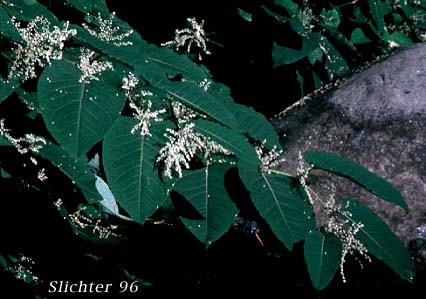

Japanese knotweed is an aggressive weedy species, introduced from Asia, with many reddish-brown freely-branched stems which arise from a rhizome. The growth of the rhizomes help the plant to spread quickly. The smooth stems may arise from 100-200 cm in height. They are woody but are deciduous, dying back over the winter. The nodes are slightly swollen and surrounded by papery sheaths. The petiolate leaves have broadly ovate leaves from 10-15 cm long and 5-10 cm wide. The blade narrows to a point.
The flowers are greenish-white to white, grouped in plume-like clusters at the ends of the stems and in the leaf axils. The fruit is 3-sided, black and shiny.
Japanese knotweed may be found as a cultivated plant in yards or in disturbed places as an aggressive weed.
Japanese knotweed is found in isolated locals west of the Cascades, although it is fairly quickly spreading.
In the Columbia River Gorge, it may be found in disturbed places west of Dog Mt between the elevations of 100'-300'.
Paul Slichter